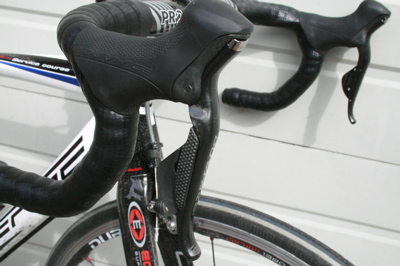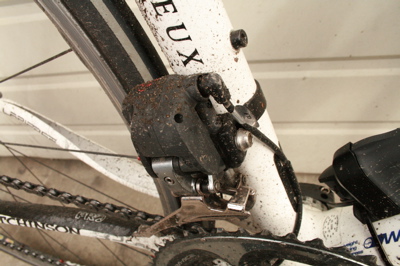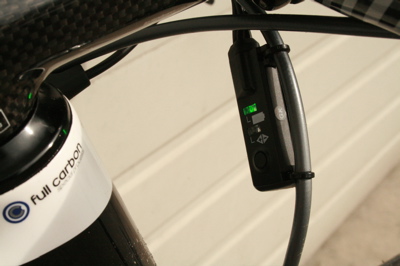 Dura Ace 7970, or Di2, is the much anticipated, electronic shifting system that Shimano debuts this year. It will be the most technologically advanced and, not coincidentally most expensive, shifting system ever offered to the public. The debates rage about what Di2 will mean for Shimano’s future market position as well as cycling in general. But who cares about that? I don’t buy bike stuff as collectibles, I buy bikes like drugs…they’re only fun if you use them…and I’m always looking for a bigger rush. Di2 is premium-grade for sure, but is the party worth the price of admission?
Dura Ace 7970, or Di2, is the much anticipated, electronic shifting system that Shimano debuts this year. It will be the most technologically advanced and, not coincidentally most expensive, shifting system ever offered to the public. The debates rage about what Di2 will mean for Shimano’s future market position as well as cycling in general. But who cares about that? I don’t buy bike stuff as collectibles, I buy bikes like drugs…they’re only fun if you use them…and I’m always looking for a bigger rush. Di2 is premium-grade for sure, but is the party worth the price of admission?
When Shimano said they wanted to give me a little sample ride of electronic Dura Ace, how could I just say no? I had to try it once at least.
Shimano’s Tommy Magrath brought me the Di2, hung on a new Lapierre X-lite2, a full carbon race machine from the French bicycle manufacturer. The frame was too big for me, but luckily today’s sloping geometry means that I could cheat a little. I only had an hour or so to roll the Di2, but since Seattle’s winter that wouldn’t go away had left the streets drenched and me a bit under the weather, just one ride in the cold and wet would be enough for me. Besides, the second most common question that people have about Di2 is “what happens when it gets wet?” Surely this would be an excellent opportunity.
 The first thing about Di2 that caught my eye was the lever. Largely freed of the design constraints of burying a mechanical shifter within the lever, Shimano engineers created their concept of ideal ergonomics. Not that I could fault them; I found the lever quite comfortable from either the hoods or the drops. The body was a little more slender and the knob on the front a bit less dramatic. The lever itself curves forwards convexly just below the pivot and is somewhat broad across. It fits my hand well. If for a reasonable cost I could buy these levers to run on my fixed gear, strictly for their ergonomics as a brake lever and a continuation of the upper surface handlebar contour, I would.
The first thing about Di2 that caught my eye was the lever. Largely freed of the design constraints of burying a mechanical shifter within the lever, Shimano engineers created their concept of ideal ergonomics. Not that I could fault them; I found the lever quite comfortable from either the hoods or the drops. The body was a little more slender and the knob on the front a bit less dramatic. The lever itself curves forwards convexly just below the pivot and is somewhat broad across. It fits my hand well. If for a reasonable cost I could buy these levers to run on my fixed gear, strictly for their ergonomics as a brake lever and a continuation of the upper surface handlebar contour, I would.

Yet their raison d’etre is to present the electric shift buttons, and I cannot say that I never mis-shifted. The shift buttons are close together, positioned as analogues of their mechanical STI brethren, but whereas the mechanical predecessor’s shift interface naturally imparted tactile feedback to the fingers, Di2 has none. Since the physical effort and button travel (which is very short compared to any mechanical shifter) is the same for both buttons, the only difference between an upshift and a downshift is a few millimeters difference in location on the lever. After riding in the wet and fairly cold, I will attest that the Di2 shifts well if you hit the right button, but I missed that shift more than once because I couldn’t precisely find the intended button with my heavily-gloved fingers. To be fair, my errors diminished in frequency the more I rode.
The levers are the user interface of the system, but possibly the most important feature of Di2 in terms of system reliability is going to be the wiring and seals. The cables and connectors all seem to be well made and precise, which is of the utmost importance in sealing out water. Many readers may remember Mavic’s attempts at electronic shifting; the Achilles’ heel of the original Zap system was that they went tits up in the rain. The 2nd generation Mechtronic tried to sidestep that issue by making the components wireless and totally sealed, but Shimano decided that the power requirements of a wireless system would have required a separate battery for each component. Shimano definitely put a lot of time into developing the connectors. One quirk is that Shimano is adamant that the connectors only be separated with the special tool included with the system, but since the Di2 Lapierre bike functioned flawlessly despite being driven car-top through the Pacific NW’s rain for weeks, I can assume that the effort has paid off. So we know the answer to the second most common question about Di2.
Of course, the most common question about Di2 is “What happens when the battery runs out?” I didn’t have a chance to answer this question for myself, because it’s not like the company rep would give me a bike with a nearly dead battery. Tommy said that there is an LED indicator that pulses red when you shift after the battery gets really low, and then eventually the derailleurs would freeze in their last position. But the battery charge should last at least a 1000km of frequent shifting. That means you could leave the charger at home for a weekend stage race, but if it was a whole week race series you’d probably be prudent to charge at some point.

The battery, connectors, and shifters all exist to communicate the rider’s choice of gear ratios, ie where the chain lies. It’s the derailleurs that do the work, but what’s unexpected is how much they disappear from mind. They just do their thing whenever you ask and never complain. Even on the best mechanical systems, an experienced rider subtly and subconsciously changes pedal pressure to ease shifting. That’s unnecessary with Di2, and the difference is dramatic with the front derailleur. I press a button; the front derailleur makes it happen with uncanny confidence. I could not trip up that thing no matter how ridiculous I timed my shifts or stomped the pedals.
So Shimano Di2 seems like the real deal, but it’s gonna cost you. I’m still working on getting exact pricing, though. I can tell you that I won’t be getting Di2 for myself. I work in a shop so I don’t pay retail for anything, but I work in a shop, so I can’t pay much. And Di2 is out of my league. But it feels really good.
…We're riding townies, adventure, and mountain bikes. Find recommendations on our store page. As Amazon Associates we earn from qualifying purchases.